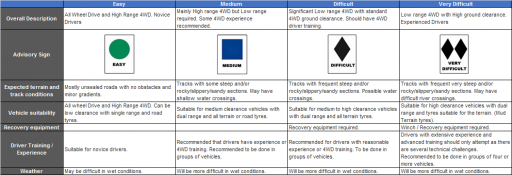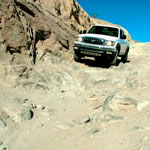Thanks NotGumby and yes I think there are a few out there - point I was trying to make was should OB members should using some standard to show the difficulty.... personally I like the idea of symbols rather than numbers and that a “double black diamond” even sounds really hard
FYI here’s the rating at overlandjournal - but let’s Ken said there’s a few out there
(1) IMPROVED/GRADED DIRT ROAD
Passable by most standard vehicles, excluding those with low hanging body panels or that are designed for on-road sport driving with ultra low ride and tire section height.
(1.5 )
GRADED DIRT ROAD
Still passable by most 2WD vehicles. However, caution is required and lower speeds may be necessary for vehicles with less clearance. Small rocks (less than 5") may be embedded in road surface. Sufficient room for passing on most of the road. Some steep grades possible. AWD required if road is wet or icy.
(2 )
FORMED TRACK
Not passable by standard passenger vehicles. High clearance preferred, AWD preferred. Steep grades present, larger rocks embedded in trail (less than 7"). Some loose trail surfaces and shallow water crossings possible. A spotter may be required on the most challenging portions to prevent body damage on vehicles with less clearance. Sand and dry washes may challenge available traction requiring lower air pressure on some vehicles. Trail may be narrow and require backing to allow other vehicles to pass.
(2.5)
RUGGED TRACK
Not suitable for 2WD vehicles, or low clearance cross over vehicles. AWD required, low range gearing preferred. Rutted, crossed axle terrain possible, with loose, steep climbs required. Deep sand possible. Some rock crawling possible on loose rocks up to 8" in diameter. Some larger rocks may be present, possibly requiring a spotter to negotiate. Small ledges possible, with larger embedded rocks present. Water crossing to 12" possible. Loose surfaces will be present, with tight clearance, smaller margin for error, and the possibility of body damage. Within the capability of any high clearance stock SUV or truck. AWD cross-over vehicles will struggle and may suffer damage due to lack of low range gearing.
(3)
FORMED TRAIL
High Clearance SUV or Truck required with low range gearing. Trail will be very rough and heavily eroded, with large, loose rocks present and steep, loose climbs requiring good traction and driver skill to negotiate. Wheel placement critical. Skid plates required, along with larger tires (31"+) necessary to prevent damage. Deeper water and mud crossings possible. Parts of the trail may be entirely in a wash, with loose sand and large rocks present. Possibility of rock ledges, and severe crossed axle obstacles. Good suspension articulation required to maintain traction. Rear limited slip differential or traction control system recommended to limit trail and vehicle damage.
(3.5)
RUGGED TRAIL
High clearance SUV or truck required, taller suspension and tires recommended. Few stock vehicles capable of completing the trail without damage. Very large rocks exceeding 12" present throughout trail requiring a spotter or heavily modified vehicle to traverse. Very loose and cambered climbs present, also heavily rutted requiring good suspension travel. Tall ledges present requiring good clearance or rocker panel protection. Little margin for error, and possibility of body damage. Tires must be 31"+ with aggressive tread and strong sidewalls. Lower tire pressure, skid plates, and limited slip or traction control required to prevent vehicle or trail damage. Rear locking differential and 32"+ tires recommended.
(4)
CHALLENGING TRAIL
High clearance modified vehicle required. Not within the capability of a stock vehicle without damage. Trail likely in river or wash bottom with very large rocks present. Deep mud possible requiring aggressive tires and higher speeds. Water crossings in excess of 24" possible. Heavily rutted and crossed axle terrain present, with large ledges and very steep hills with embedded and loose rocks. Body protection required to prevent damage, with good skid plates and stronger (or spare) steering components necessary. Winching and extraction possible. 32" tires, rear locking differential and flexible suspension required. 33" tires and front locking differential recommended.
outside the scope of this website
( 4.5)
EXTREME TRAIL
Heavily modified vehicle required. Extreme rock crawling, with very large ledges present requiring winching for shorter wheelbase (SWB) vehicles. Body and drivetrain damage likely. Very cambered terrain may cause rollovers. Water crossings may be hood high, and mud will be very deep and heavily rutted. Vehicles will require heavy modifications. 33"+ tires required, along with front and rear locking differentials in upgraded axles. 35-37" tires recommended. Winch required on SWB vehicles. Roll cages or full metal roof required. Driver must be experienced.
( 5)
NO TRAIL!
Custom vehicle, very experienced driver required. Competition-level vehicles on insane terrain with frequent rollovers and drivetrain damage. Full custom vehicles with massive axles, 37"+ tires, cutting brakes, very low gears, 1-ton drivetrain, and custom chassis.
















